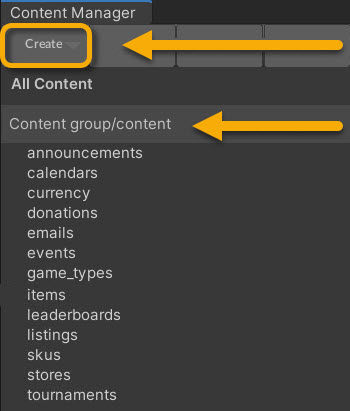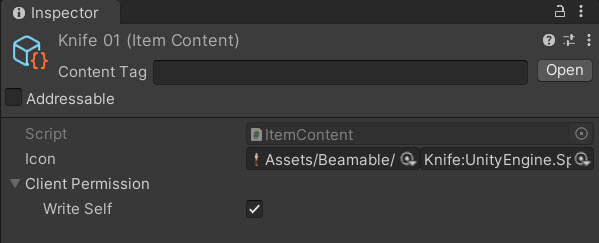Content - Guide
Create and manage your game's live content [PROF-Content-02]
The purpose of this feature is to allow game maker to store project-specific data objects. In this guide, we will create and publish a content entry, then pull the content from the server within an instance of Unity's MonoBehaviour script.
Adding Content
Game makers may create new content of _existing _content types or new content of _custom _content types. For the purposes of this guide, we will be using the existing "Item" type.
Step | Detail |
|---|---|
| • Unity → Window → Beamable → Open Content Manager |
|  • Select the content type in the list • Press the "Create" button • Populate the content name |
| • Unity → Window → General→ Project |
| • Search by the name given in step #3 |
|  Note: The icons can be set to any valid Unity’s |
| • Unity → File → Save Project Best Practice: If you are working on a team, commit to version control in this step. |
| • Press the "Publish" button in the Content Manager Window |
Downloading Content
Content that has been published to the server can be pulled from Beamable's ContentService via a ContentLink or ContentRef. Both are shown in this example.
using System;
using Beamable.Common.Content;
using Beamable.Common.Inventory;
using UnityEngine;
namespace Beamable.Examples.Services.ContentService
{
[Serializable]
public class ItemLink : ContentLink<ItemContent> {}
/// <summary>
/// Demonstrates <see cref="ContentService"/>.
/// </summary>
public class ContentServiceExistingExample : MonoBehaviour
{
// Fields ---------------------------------------
[SerializeField] private ItemLink _itemLink;
[SerializeField] private ItemRef _itemRef;
private ItemContent _itemContentFromLink = null;
private ItemContent _itemContentFromRef = null;
// Unity Methods --------------------------------
protected void Start()
{
Debug.Log($"Start()");
SetupBeamable();
}
// Methods --------------------------------------
private async void SetupBeamable()
{
var beamContext = BeamContext.Default;
await beamContext.OnReady;
Debug.Log($"beamContext.PlayerId = {beamContext.PlayerId}");
await _itemLink.Resolve()
.Then(content =>
{
_itemContentFromLink = content;
Debug.Log($"_itemContentFromLink.Resolve() Success! " +
$"Id = {_itemContentFromLink.Id}");
})
.Error(ex =>
{
Debug.LogError($"_itemContentFromLink.Resolve() Error!");
});
await _itemRef.Resolve()
.Then(content =>
{
_itemContentFromRef = content;
Debug.Log($"_itemContentFromRef.Resolve() Success! " +
$"Id = {_itemContentFromRef.Id}");
}).Error(ex =>
{
Debug.LogError($"_itemContentFromRef.Resolve() Error!");
});
}
}
}
Learning FundamentalsGame makers who are new to Unity and C# can review the fundamentals here.
The above code sample uses C# async methods. However, the same code can be written using the Promise library.• See Beamable: Asynchronous Programming for more info
Inspector
After being added to a GameObject, the Inspector will display a drop-down of all valid content entries.

Output
Click Play in the Editor and inspect the console to see that the Item content was pulled successfully.

Updated about 2 months ago
